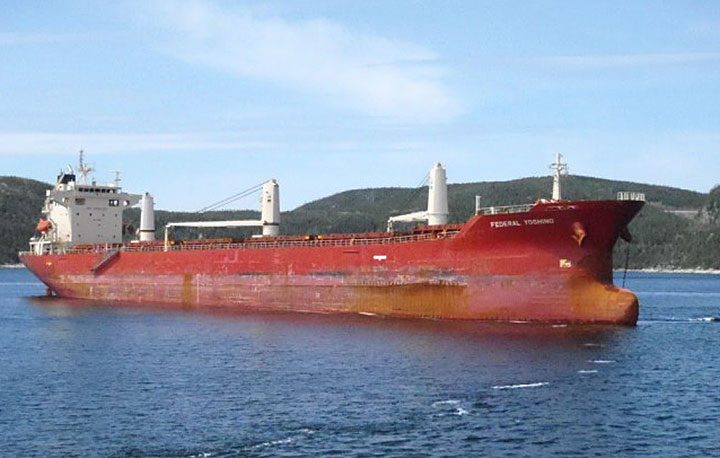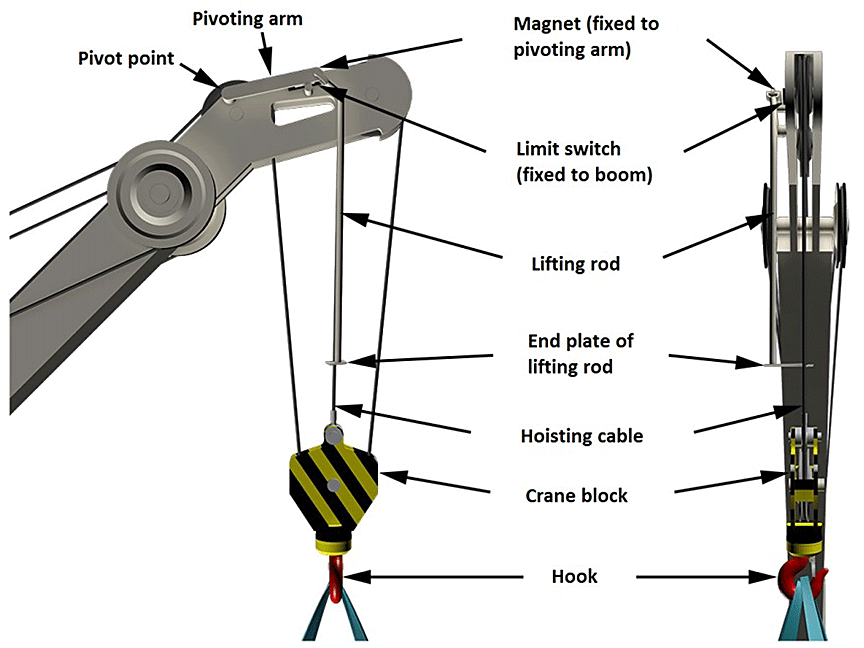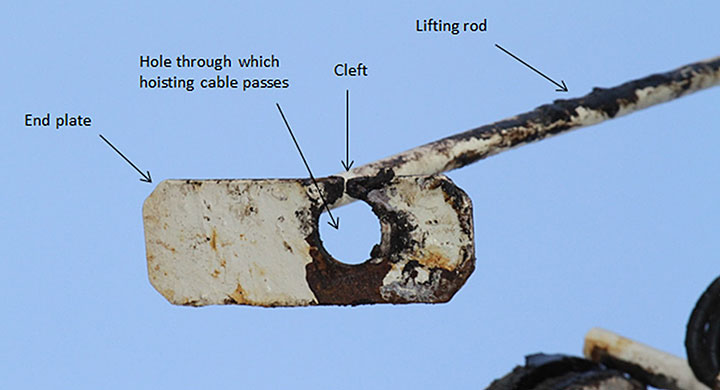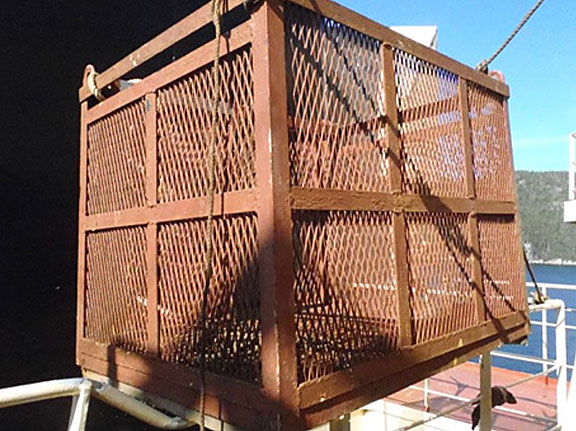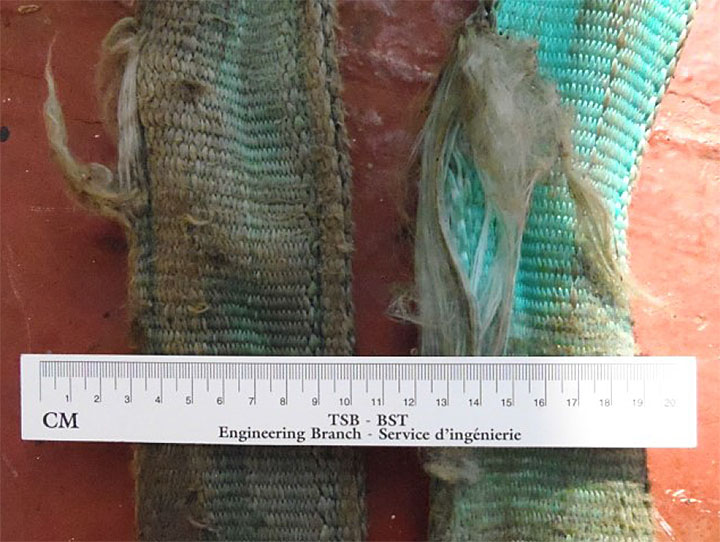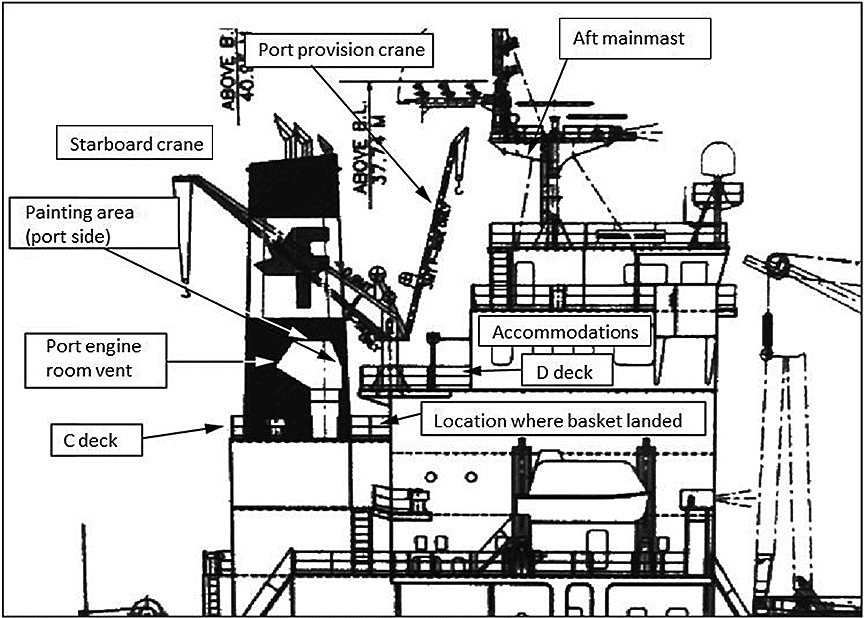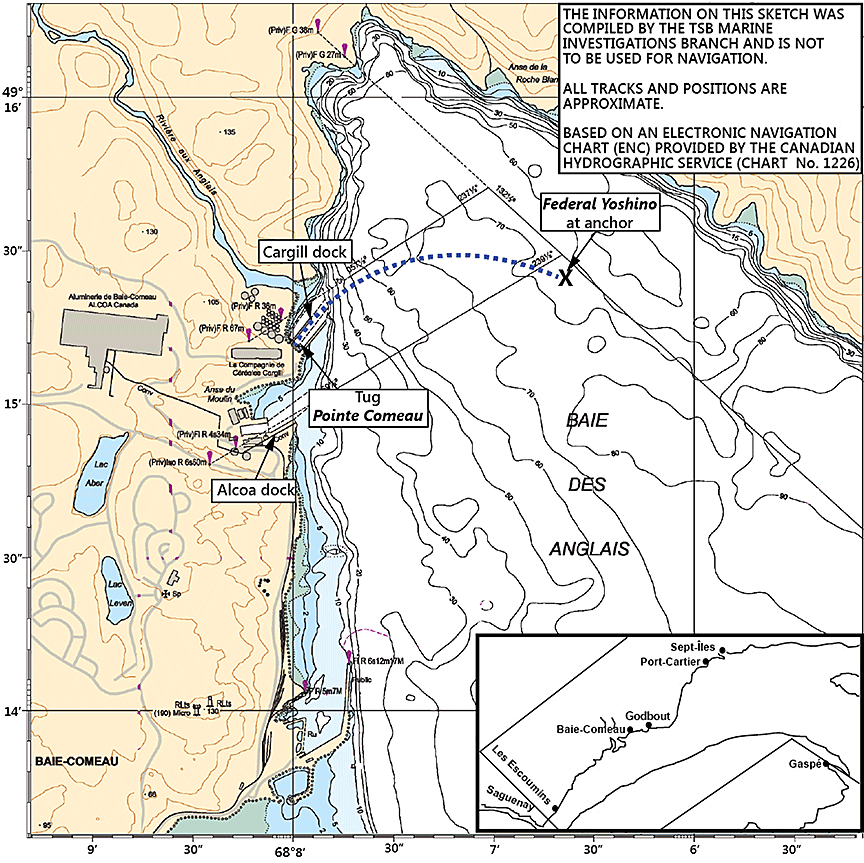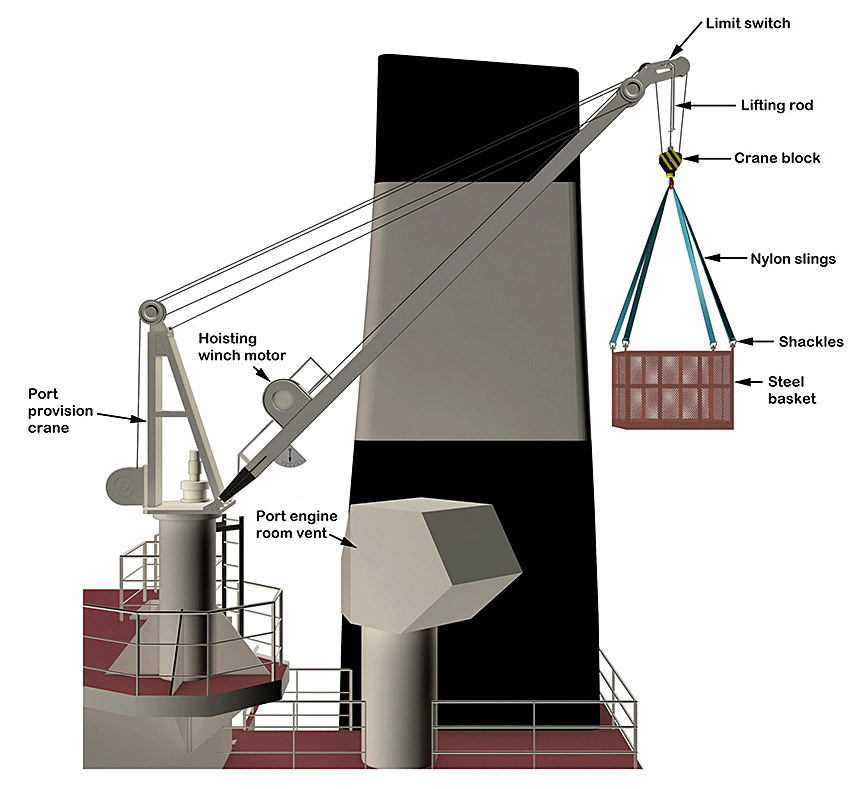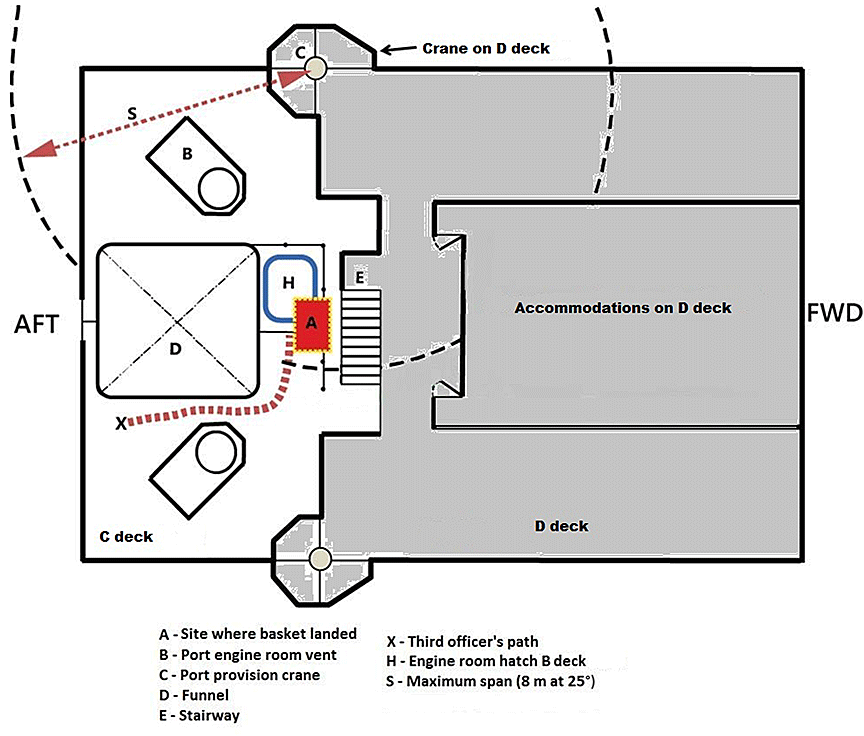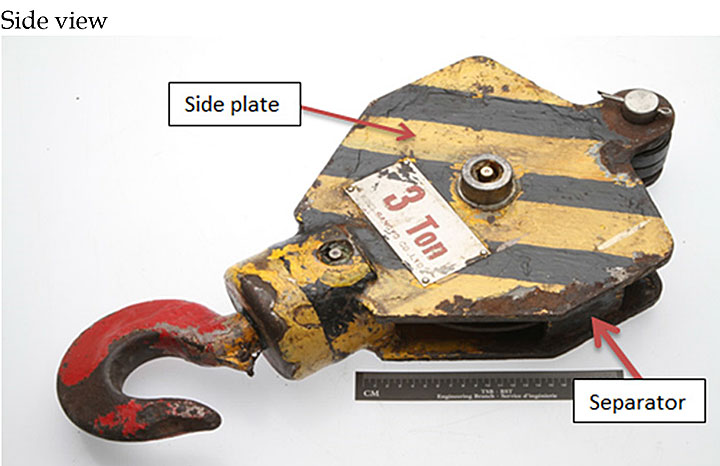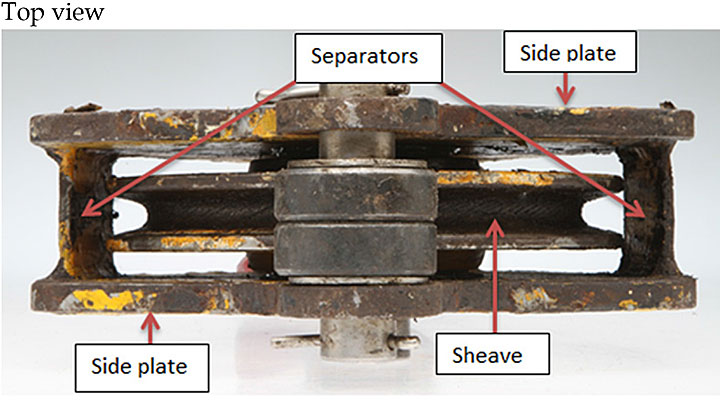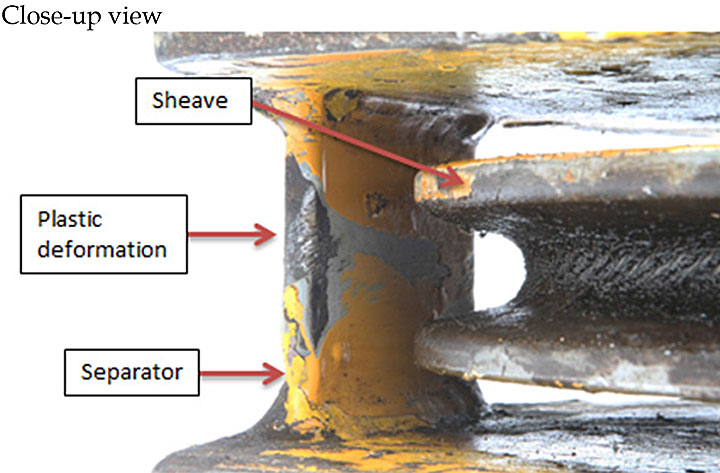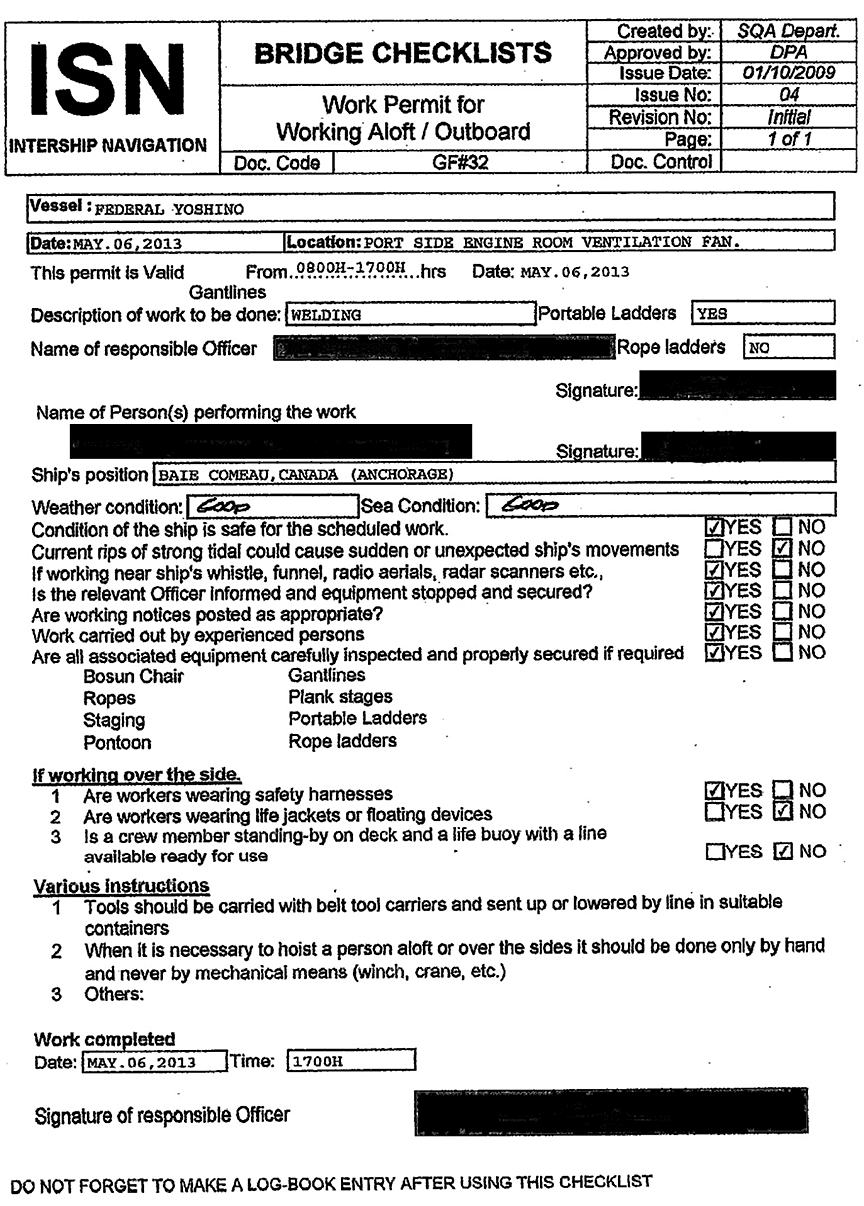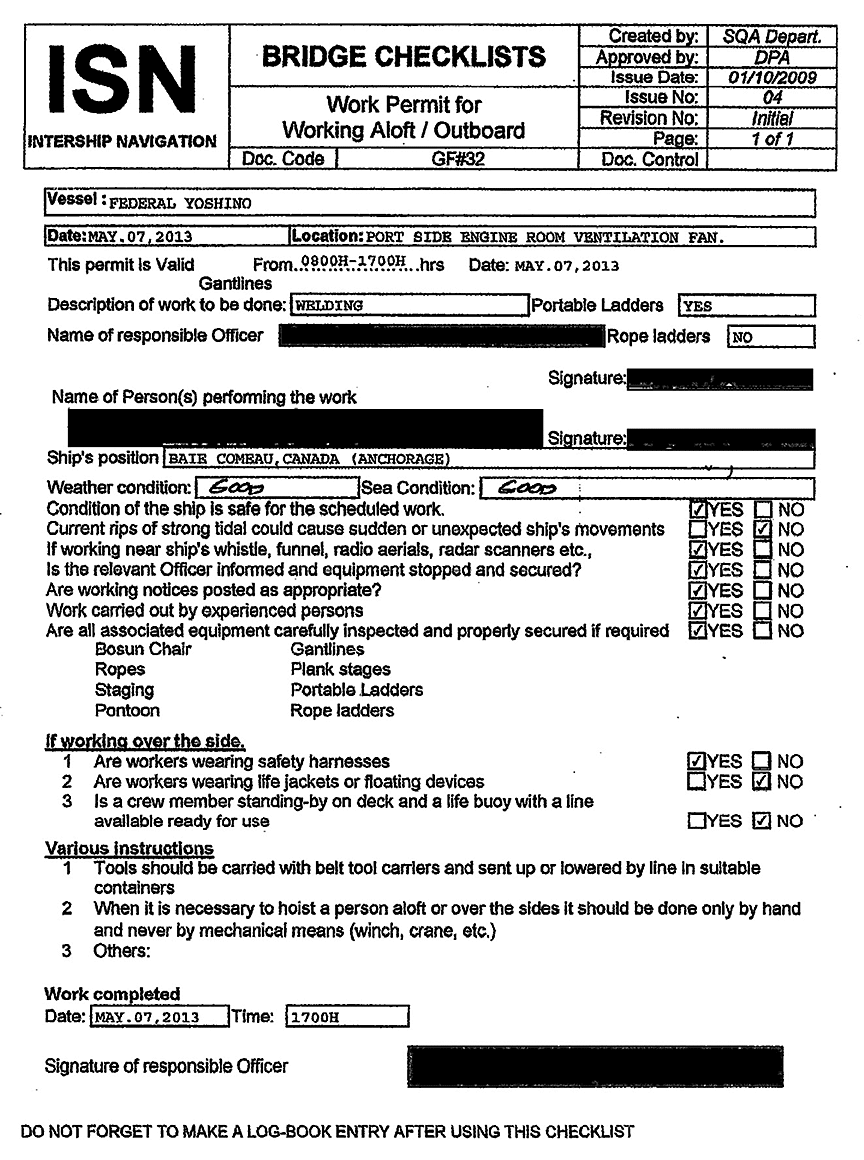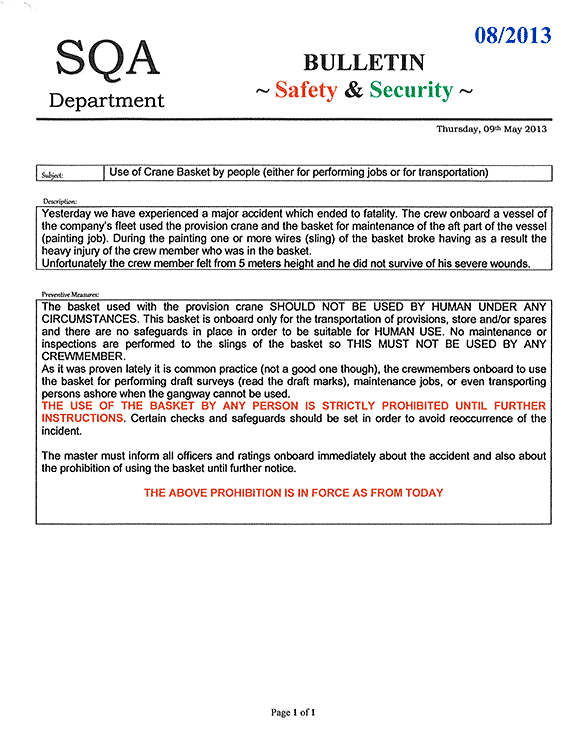Accidental death
Bulk carrier Federal Yoshino
Baie Comeau, Quebec
The Transportation Safety Board of Canada (TSB) investigated this occurrence for the purpose of advancing transportation safety. It is not the function of the Board to assign fault or determine civil or criminal liability. This report is not created for use in the context of legal, disciplinary or other proceedings. See Ownership and use of content. Masculine pronouns and position titles may be used to signify all genders to comply with the Canadian Transportation Accident Investigation and Safety Board Act (S.C. 1989, c. 3).
Summary
On 08 May 2013, at 1455 Eastern Daylight Time, the Federal Yoshino was at anchor in Baie-Comeau, Quebec, when one of the vessel’s crew members was fatally injured as a result of a fall. The crew member had been working aloft using a steel basket attached to the on-board electric provision crane when the hoisting cable parted. The basket containing the crew member fell approximately 5 m before landing on the deck. The crew member was transported to the hospital and pronounced dead on arrival.
Factual information
Particulars of the vessel
| Name of vessel | Federal Yoshino |
|---|---|
| IMO number | 9218416 |
| Port of registry | Majuro |
| Flag | Marshall Islands |
| Type | Bulk carrier |
| Gross tonnage | 19 125 |
| LengthFootnote 1 | 190.43 m |
| Draught at time of occurrence | Forward: 4.25 m Aft: 6.25 m |
| Built | 2001, Kanasashi Co. Ltd., Japan |
| Propulsion | One 2-stroke, single-acting diesel engine, developing 7061 kW at 133 rpm |
| Cargo | Ballast |
| Crew | 22 |
| Registered owner | Baffin Investments Ltd., Canada |
| Manager | Intership Navigation Ltd., Limassol, Cyprus |
Description of the vessel
The Federal Yoshino is a dry bulk cargo vessel built of steel with machinery spaces and accommodations located aft (Photo 1). The 6 cargo holds and hatches are serviced by three 30-tonne electric-hydraulic cranes mounted on the centreline of the vessel. The vessel has 1 overhead travelling crane located in the engine room and 2 electric motordriven provision cranes situated on either side of D deck, aft of the accommodations (Appendix A). The port provision crane has a 3 tonne capacity and a radius that ranges between 2.75 m and 8 m. The starboard provision crane has a 0.9 tonne capacity and a fixed boom. The starboard crane was not in service at the time of the occurrence. The bridge is equipped with all the required navigational equipment.
History of the voyage
On 14 April 2013, the Federal Yoshino departed Point Comfort, Texas, U.S., bound for Baie-Comeau, Quebec. The vessel was loaded with 25 198 tonnes of alumina. On 25 April, the vessel arrived at the Alcoa dock in Baie-Comeau and began discharging its cargo. The operation was completed in the early morning of 27 April, at which time the vessel left the dock and proceeded approximately 1 nm to the anchorage in Baie des Anglais (Appendix B), where it waited at anchor for a cargo of grain to arrive. While the vessel was at anchor, the crew attended to general maintenance on board the vessel.
On 03 May, a scheduled monthly inspection of the port provision crane was carried out as part of general maintenance. The work order, which was generated by the company's maintenance management system, required, among other things, testing of the crane's limit switchesFootnote 2 and unrolling of both the hoisting and boom cables from their respective drums to check for broken strands and corrosion. The electricanFootnote 3 inspected the limit switches and the bosun inspected the cables with the help of an ordinary seaman (OS).Footnote 4 The cables were then greased and reeled back onto the drums.
On 06 May, the fitterFootnote 5 started repairs on a portion of the port engine room vent that had corroded. The vent, located on C deck, stands approximately 5 m high (Appendix C). The fitter, therefore, hooked a steel basket to the port provision crane, got into the basket, and used the crane's remote control to manoeuvre the basket to the corroded area in order to begin working aloft. The fitter used the same arrangement on 07 May.
On 08 May, at approximately 0645,Footnote 6 the bosun met with the chief officer to plan the distribution of maintenance work for the day. The priority jobs included chipping and painting the No. 2 cargo crane and jib, and chipping and painting the aft mainmast. Three crew members were assigned to complete these jobs and, because they involved working aloft, the chief officer prepared 3 work permits for working aloft. Once the work permits were completed and signed, the crew members rigged stagesFootnote 7 and began to work. The bosun and the chief officer had also discussed an additional job: painting the portion of the port engine room vent that the fitter had repaired. In the early afternoon, the bosun took the initiative to begin this job.Footnote 8 The bosun got into the steel basket attached to the port provision crane, the same one that the fitter had used previously. After attaching his safety belt to the crane's hook, the bosun got into the basket and used the remote control to manoeuvre the basket to the upper portion of the vent.
Just before 1500, the bosun stopped painting to take a coffee break. Using the remote control, the bosun began manoeuvring the steel basket from the port vent inboard, in order to bring the basket down on the starboard side of C deck (Appendix D). At the same time, the third officer was performing a security check of the safety equipment on the starboard side of C deck when he heard liquid spilling onto the deck. The liquid was coming from the steel basket that the bosun was manoeuvring towards the deck. The third officer called to the bosun that paint was leaking onto the deck, and the bosun acknowledged this with a reply. The third officer walked towards the spot where the paint had spilled, at which point a snap was heard. The third officer looked up and then stepped back at the same moment the basket containing the bosun fell approximately 5 m. It landed on a railing forward of the funnel on C deck, directly in front of the third officer (Appendix D). The crane block assembly and the slings that had been attaching the basket to the crane landed inside the basket (3D Animation).Footnote 9 Immediately following the accident, the crew members removed the bosun from the basket and administered first aid.
Marine Communication and Traffic Services (MCTS) Les Escoumins received a call for medical help from the Federal Yoshino at approximately 1503. The tug Pointe Comeau, which was tied up at the Cargill dock, was tasked to transport the paramedics to the vessel in order to render assistance. Shortly after 1600, the bosun arrived at the hospital and was pronounced dead.
Environmental information
At the time of the occurrence, the sky was clear and the visibility was about 5 miles in the Baie-Comeau region. The wind was from the SE at 10 to 12 knots, and the sea was calm. The temperature was approximately 18° C.
Personnel certification and experience
The master, officers, and crew all held certificates of competency valid for the vessel and voyage being undertaken. The master held a Master Mariner certificate of competency and had sailed as a master on various vessels belonging to the same company since March 2012. The master joined the Federal Yoshino in January 2013.
The chief officer held a Chief Mate certificate of competency and had been sailing in that capacity on different vessels since July 2005; the chief officer joined the Federal Yoshinoin February 2012 and had held the position of chief officer since that time.
The bosun was issued a Deck Rating certificateFootnote 10 on 27 May 2008 and had worked for the company since 25 March 2007. The bosun joined the Federal Yoshino on 28 November 2012.
Vessel certification
The Federal Yoshino was crewed, equipped, and certified in accordance with existing regulations and held a safety management certificate issued by the recognized organization Det Norske Veritas (DNV). The vessel was thus in compliance with the requirements of the International Safety Management Code for the Safe Operation of Ships and for Pollution Prevention (ISM Code).
Crane certification
The vessel possessed aCertificate of Test and Thorough Examination of Cranes or Hoists and their Accessory Gear that was valid for the vessel's 3 cargo cranes, the port provision crane, and 1 overhead travelling crane in the engine room. The certificate was issued on 30 January 2011 by Nippon Kaiji Kyokai (NKK) and was valid for a period of 5 years, conditional to annual inspections. The cranes underwent annual inspections in January 2012 and 2013;Footnote 11 both annual inspections and resulting endorsement were listed in the vessel's cargo gear book.
A certification inspection performed by a recognized organization such as NKK or DNV assesses the suitability of a crane for its intended purpose. Because the port provision crane was intended for the transfer of provisions, it was only inspected and certified for hoisting provisions.
Port provision crane
The purpose of the port provision crane on the Federal Yoshino was to transfer supplies (e.g., engine parts, galley supplies, and deck supplies) between the vessel and the dock. The port provision crane was operated using a push button remote control, enabling the crane operator to manoeuvre the crane from various vantage points on the deck. The remote control could be used for raising and lowering the hook, slewing the crane right and left, and luffing the boom up and down. The boom had a maximum radius of 8 m (when at a 25° angle) and a minimum radius of 2.75 m (when at a 75° angle). Post-occurrence photographs indicated that the angle on the boom was approximately 45° at the time of the accident.
The crane blockFootnote 12 on the port provision crane was constructed of steel and included the hook and sheave (Appendix E). The hoisting cable, which was 10 mm in diameter, passed around the sheave. The sheave was enclosed by side plates that were reinforced by separators. A post-occurrence examination of the separators revealed that one of them (the separator nearest to the point where the hoisting cable exited the sheave and connected to the winch) had sustained plastic deformationFootnote 13 (Appendix E).
Limit switch
Most cranes are equipped by the manufacturer with limit switches. On the port provision crane, the hoisting winch (used to raise and lower the hoisting cable) was driven by an electric motor that was connected to a limit switch. This limit switch was located on the boom head (Figure 1) and worked in conjunction with a magnet on the pivoting arm to prevent the crane block from making contact with the boom head and potentially overstressing the hoisting cable.
When the crane block was operating within its set limits, the magnet fixed to the pivoting arm rested in line with the limit switch, creating a closed electrical circuit that allowed the motor to operate. However, if the crane block traveled upward beyond a set limit, it would push up on the lifting rod's end plate (Figure 1). This action on the lifting rod would cause the pivoting arm to pivot upwards, de-aligning the magnet from the limit switch and opening the electric circuit, which would cut power to the motor. For the limit switch to be activated, the pivoting arm needed to pivot upwards by approximately 10° (3D Animation).Footnote 14 Post-occurrence, the pivoting arm was observed to be resting at an angle of approximately 90° in relation to the limit switch.
In order for the lifting rod to function as intended, it was designed to be fitted such that the hoisting cable passed through a hole in the lifting rod's end plate (Photo 2). This secured the end plate of the lifting rod around the hoisting cable and held the lifting rod in line with the crane block (while still allowed the hoisting cable to move freely up and down through the hole in the end plate). When under tension and fitted correctly through the end plate, the hoisting cable would normally be suspended parallel to the rod itself, separated from it by a distance of approximately 10 cm (Figure 1, front view).
Following the occurrence, the lifting rod was found to be structurally intact. There was grease visible on the rod itself, but minimal grease visible on the end plate. Between the hole through which the hoisting cable was to pass and the outer edge of the end plate, there was a cleft that was approximately 10 mm wide (Photo 2).
After the accident, the limit switch was changed by the crew. At the request of the Transportation Safety Board (TSB), the master provided the limit switch that had been in place at the time of the occurrence. This limit switch was bench tested for continuity using a multi-meter and 2 different strength magnets and was found to work as intended.
Requirements for shipboard cranes
DNV, which conducted the 2013 inspection of the Federal Yoshino's cranes, has rules and specific requirements respecting shipboard cranes used for the lifting of personnel. Among other things, DNV specifies that the hoisting cable must have a minimum safety factor of 8, and that winches are to be equipped with 2 mechanically and functionally independent brakes.
The hoisting cable in use at the time of the occurrence had a safety factor of 5, which is the standard for provision cranes. The winches on the port provision crane were not equipped with independent brakes.
Steel basket
To facilitate the transfer of supplies, the crew on the Federal Yoshino used a steel basket that could be hooked to the on-board provision cranes. The basket, fabricated by the vessel's crew, was made of steel angle bars, flat bars, and metal grating (Photo 3). It weighed 200 kgFootnote 15and was 96 cm high. Its base measured 102 by 132 cm.
At the time of the occurrence, the basket was attached to the hook of the port provision crane by means of 2 nylon slings that were approximately 4.2 m in length. The slings were secured to the basket by 4 shackles. A post-occurrence examination found that the nylon slings were worn (Photo 4) and that the working load limit was marked on 2 out of the 4 shackles. None of the threaded pins on the 4 shackles were moused.Footnote 16
Safety standards for lifting baskets
While DNV does not have specific standards for the construction and certification of lifting baskets, they do have instructions for their surveyors to follow when using such equipment to carry out on-board surveys. These instructions specify that the basket/platform and lifting gear must be certified for the applicable safe workload and certified for the transportation of personnel. They also specify that equipment is to be checked immediately prior to the lifting operation to ensure that
- there are no kinked wires or damaged shackles;
- the personnel basket is secured to the hoisting cable; and,
- there is a safety latch on the crane hook to prevent the rigging from inadvertently coming off the hook.
Transport Canada (TC) has set out regulations to be observed with respect to the inspection and testing of apparatuses used for the transfer of personnel, such as lifting baskets.Footnote 17 TC specifies that these apparatuses be inspected and tested before being placed in service, after any alterations are made, and once every 12 months. These inspections are to be performed by a qualified person and a record is to be kept on the vessel. TC further specifies that these apparatuses be “inspected and found to be in serviceable condition before each use, and all ropes, wires, or other vital parts that show sign of significant wear must be replaced before the apparatus is used.”Footnote 18
Procedures for working aloft
Working aloft is defined as working from a height that involves a risk of injury by falling. It is normally done using the rigging of stages, boatswain's chairs, or portable ladders and involves protective equipment such as safety lines or harnesses. The Federal Yoshino's safety management system (SMS) included a work permit checklist to be filled out by responsible officersFootnote 19 before they were tasked to work aloft. Checklist items included the consideration of the safety of weather and sea conditions, the use of appropriate personal protective equipment, and ensuring that the work was being carried out by experienced persons.
Under a section called “Various instructions,” the checklist stated: “When it is necessary to hoist a person aloft or over the sides it should be done only by hand and never by mechanical means (winch, cranes, etc.).”The checklist was to be completed by the responsible officer and signed off by both the responsible officer and the crew member to which the work had been assigned.
In the week of the occurrence, the provision crane and the basket had been used twice by the fitter to work aloft. On both occasions, a work permit for working aloft had been issued (Appendix F) and the master was aware that the port provision crane and basket had been used by the fitter for this purpose.
Previous occurrence
On 24 February 2013, a similar occurrence took place in Baie-Comeau, Quebec, on the Federal Leda. In this occurrence, the chief officer, who had been reading the vessel's draught while suspended in a basket, fell into the water and sustained minor injuries.Footnote 20 The report to the company stated that the hoisting cable of the provision crane had broken.Footnote 21 As a corrective measure, the master of the Federal Leda stated that, in the future, the on-board hoisting cable should be checked carefully before each use.
The Federal Leda and Federal Yoshino are owned by different companies but share the same management company.
Analysis
Events leading to the accidental death
At the time of occurrence, the bosun was working alone using a crane that was not suitable for lifting personnel. While the bosun was manoeuvring the crane, the crane block exceeded its set limit, but the limit switch was not activated and the electric motor kept operating. From inside the basket, the bosun's view of the crane block was obstructed, limiting his ability to identify that it had exceeded its set limit. The crane block made contact with the underside of the boom head and the winch continued to pull, overstressing the hoisting cable and bringing it in contact with the separator plate.Footnote 22 The combination of overstress and contact with the separator plate caused the cable to part,Footnote 23 Footnote 24 releasing the basket in a 5 m free-fall. The bosun was transferred to a hospital and was pronounced dead.
Failure of the activation of the limit switch
In this occurrence, the limit switch did not activate as intended to cut power to the electric motor. The limit switch was found to be in good working condition and the lifting rod was found to be structurally intact. It is likely that the limit switch was not activated because the hoisting cable was not fitted through the hole in the lifting rod's end plate. In this situation, the unsecured lifting rod would have been pushed aside by the crane block, rather than up, and the limit switch would not have been activated (see 3D Animation).Footnote 25
This incorrect rigging of the hoisting cable with the lifting rod is also suggested by the lack of grease on the lifting rod's end plate and by the extent of grease on the rod itself. The hoisting cable in this occurrence had been freshly greased 5 days prior. In a situation where the freshly-greased hoisting cable passed through the hole in the end plate, the transfer of grease from the hoisting cable to the end plate would be expected; however, minimal grease was present on the end plate. Furthermore, the rod itself had a significant amount of grease on it, suggesting that it had likely dangled freely alongside the hoisting cable and had rubbed against it.Footnote 26
During the routine maintenance on 03 May, it is possible that the hoisting cable was removed from the lifting rod's end plate to facilitate greasing of the cable and was not fitted back through the end plate after the maintenance had been completed.
Working aloft
Equipment
Working aloft involves an inherent risk of falling; as such, it is important that equipment used for lifting personnel, such as baskets, cranes, and rigging, be certified accordingly and regularly inspected and maintained. Ensuring that this equipment is fitted with the necessary safety features (such as a hoisting cable with a higher safety factor and additional braking capacity on hoisting and luffing winches) also safeguards against the risk of falling.
On the Federal Yoshino, the port provision crane was being used to lift personnel aloft despite the fact that it was not suitable for this purpose: it was not certified for lifting personnel, its hoisting cable did not meet the required safety factor, and it did not have additional braking capacity. Furthermore, neither the basket nor the rigging was subject to regularly-scheduled maintenance, as they were not included in the company's maintenance management system. If equipment that is not suitable for working aloft is used for this purpose, the risk of injury or death to crew members is increased.
Work procedures
Companies that are subject to the International Safety Management Code for the Safe Operation of Ships and for Pollution Prevention (ISM Code) are required to develop procedures to mitigate risks associated with various tasks on the vessel. These procedures may include checklists that can be used to make crew members aware of risks requiring mitigation strategies.
In consideration of the inherent risks involved with working aloft, the Federal Yoshino's work permit checklist specified that the procedure for lifting a crew member aloft should be done by hand and not by mechanical means (a winch, cranes, etc.). However, there was no indication that this procedure was enforced on board, despite the fact that the port provision crane was unsuitable for lifting personnel and there were no safe work practices in place to mitigate risks (such as a requirement for a dedicated crane operator or a requirement for the operator to test limit switches prior to use).
If procedures in place to protect the safety of crew are not enforced, the risk of injury or death to crew members is increased.
Findings
Findings as to causes and contributing factors
- Although the crane was not suitable for lifting personnel, it was being used to work aloft.
- The limit switch did not cut power to the electric winch motor when the crane block exceeded the set limit, likely because the lifting rod was not properly rigged.
- The bosun's view of the crane block was obstructed from the position inside the basket, limiting the bosun's ability to identify that the block had exceeded its set limit.
- The crane block made contact with the underside of the boom and the winch continued to pull, causing the hoisting cable to part and the basket to fall approximately 5 m.
Findings as to risk
- If equipment that is not suitable for working aloft is used for this purpose, the risk of injury or death to crew members is increased.
- If procedures in place to protect the safety of crew are not enforced, the risk of injury or death to crew members is increased.
Safety action
Safety action taken
Fednav Limited
Following the occurrence, Fednav Limited immediately instructed Intership Navigation Company Limited to stop the use of the provision cranes for lifting personnel. Fednav Limited also indicated that safe working practices will be a main focus for future inspections of vessels under their ownership.
Intership Navigation Company Limited
On 09 May 2013, the day following the accident, the Safety and Quality Assurance department issued a safety and security bulletin (Appendix G) to all vessels under management by Intership Navigation Company Limited strictly forbidding the use of the basket with the crane for human transport or work until further notice. The bulletin noted that certain checks and safeguards should be established to avoid any reoccurrences of the incident and that, until further notice, the master must inform all officers and ratings on board immediately about the accident and the prohibition on using the basket. The bulletin entered into force on its date of issue.
On-board safety training of crew and officers, which focused mainly on following the company safety procedures, was carried out on all vessels managed by Intership Navigation Company Limited.
Det Norske Veritas Germanischer Lloyd
On 14 February 2014, Det Norske Veritas Germanischer Lloyd issued a casualty information newsletter intended for the maritime industry. The newsletter focused on the suitability of lifting equipment for the transport of personnel and also addressed the importance of checking safety functions before lifting operations, e.g., limit switches for all lifting appliances.
Marshall Islands (Flag State)
On 06 February 2014, the vessel's administrator addressed a letter to Intership Navigation Company Limited with the following recommendations:
- Review and, as appropriate, revise procedures for familiarizing senior officers with the requirements of the safety management system;
- Review and, as appropriate, revise procedures for verifying shipboard compliance with the safety management system;
- Revise the work permit for working aloft or over the side to incorporate the express prohibition regarding the use of baskets to hoist personnel that was included in the Safety Bulletin issued on 09 May 2013; and,
- Mark baskets intended for ransferring provisions, etc., to state that they are not to be used to hoist personnel.
The findings of the flag state investigation into the occurrence were shared with the administrator's staff responsible for conducting flag state vessel inspections. Spot checks for compliance with shipboard permits to work aloft/over the side were also recommended.
This report concludes the Transportation Safety Board's investigation into this occurrence. The Board authorized the release of this report on . It was officially released on .
Appendices
Appendix A – Partial view of Federal Yoshino’s starboard side
Appendix B – Area of occurrence
Appendix C – Port provision crane
Appendix D – View of occurrence location from above
